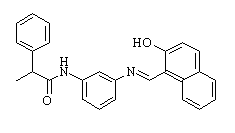Salermide
| CAS No. | 1105698-15-4 | Cat. No. | BCP19469 |
| Name | Salermide | ||
| Synonyms | |||
| Formula | C26H22N2O2 | M. Wt | 394.47 |
| Description | InVitro: Salermide shows a dose-dependent inhibition that rises to 80% at 90 μM and 25 μM against Sirt1 and Sirt2, respectively. Salermide can prompt tumour-specific cell death in a wide range of human cancer cell lines derived from leukaemia (MOLT4, KG1A, K562), lymphoma (Raji), colon (SW480) and breast (MDA-MB-231). Incubation with 100 μM Salermide alone results in an increase of cytosolicactivated caspase 3 and a decrease of mitochondrialcytochrome. Salermide alone can induce apoptosis through both extrinsic and intrinsic pathways. Salermide had several antitumorigenic advantages over the earlier described class III HDAC inhibitors: firstly, it mimics the universal proapoptotic effect on cancer samples exhibited by the classical class I, II and IV HDAC inhibitors, and secondly, its proapoptotic effect is cancer-specific. InVivo: Salermide is well tolerated by mice at concentrations up to 100 μM. Salermide's mechanism of action in vivo is specifically mediated by Sirt1. Intraperitone | ||
| Pathways | Cell Cycle/DNA Damage Epigenetics | ||
| Targets | Sirtuin | ||
Structure

Part data of this page collected from the open network resources, so Biochempartner can not guarantee its accuracy.
For product details of different batches, please contact our Customer
- Service & Tech Support:orders@biochempartner.com
- Website:www.biochempartner.com
Products are for research use only and not for human use. We do not sell to patients.
